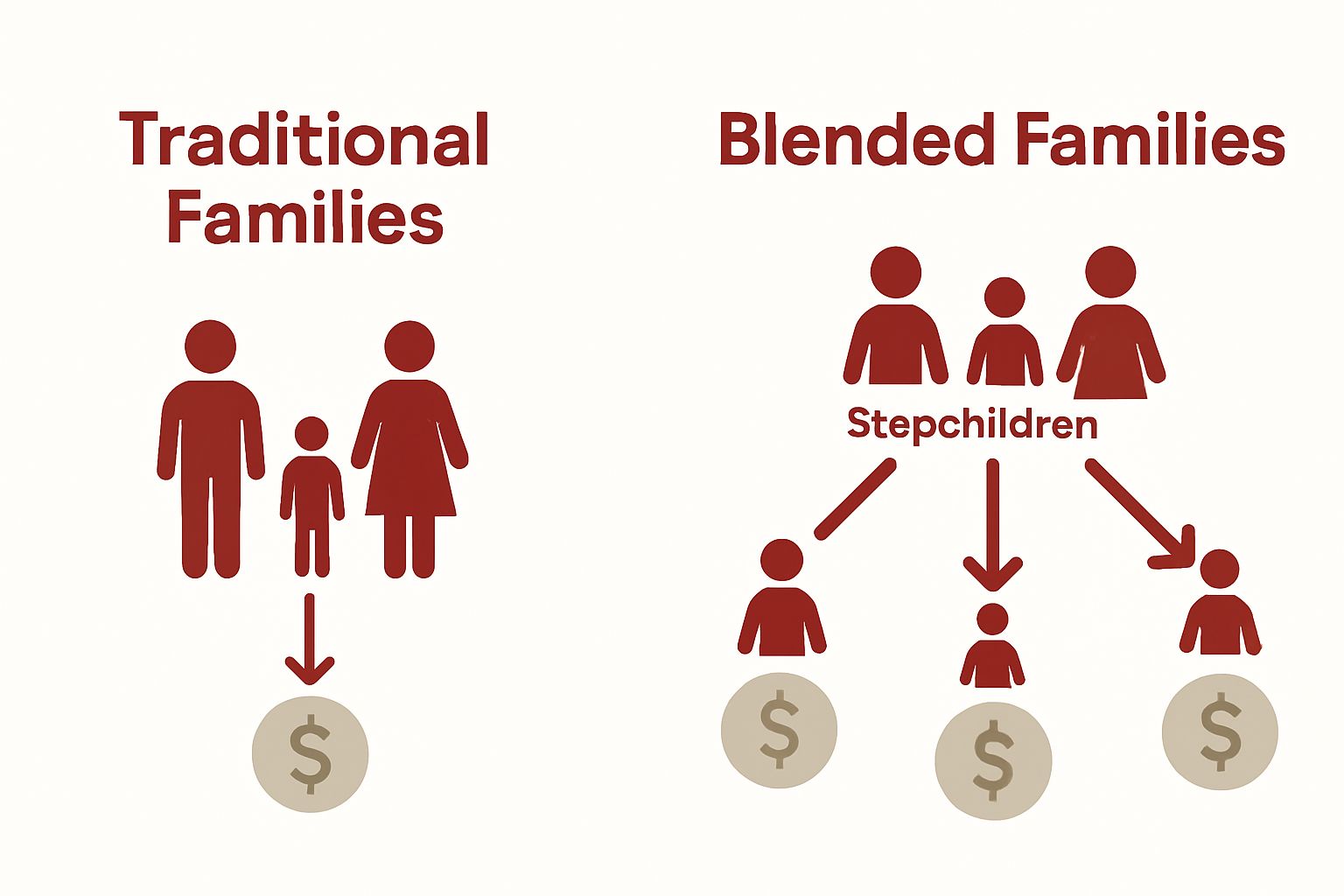
PARENTS & HOMEOWNERS: MY 7-STEP ESTATE PLANNING PROCESS WILL PROTECT YOUR HEIRS
From Creditors, Predators & Bad Choices, And Will Help You Become a (Bigger) Hero to Your Family!



Understanding Blended Family Estate Planning for California Families
Blended families now make up over 40% of all family structures in the United States, changing the way people think about inheritance and asset protection. Most assume a simple will is enough and everyone stays happy. But in reality, standard estate planning can leave stepchildren without a dime or even spark fierce legal battles. The real surprise is that thoughtful blended family estate planning is not just about money. It is about protecting relationships and preventing heartbreak before it starts.
Table of Contents
- What Is Blended Family Estate Planning?
- Why Blended Family Estate Planning Matters
- Key Concepts In Blended Family Estate Planning
- How Blended Family Dynamics Impact Estate Planning
- Managing Wealth And Protecting Children In Estates
Quick Summary
| Takeaway | Explanation |
|---|---|
| Blended family estate planning is essential | This unique planning addresses complex family dynamics, ensuring everyone’s financial interests are protected. |
| Use advanced trust structures for asset management | Trusts like QTIP provide flexibility, protecting biological children’s rights while supporting current spouses. |
| Clarify beneficiary designations | Careful designation in non-probate assets prevents unintentional disinheritance among family members. |
| Address emotional complexities during planning | Recognizing the emotional dynamics helps reduce potential family conflicts and maintain harmony. |
| Implement staged inheritance for financial protection | Age-based distributions safeguard children’s financial futures and promote responsible asset management. |
What is Blended Family Estate Planning?
Blended family estate planning represents a sophisticated legal strategy designed to protect and manage assets for families formed through remarriage, where children from previous relationships are involved. Unlike traditional estate planning, this specialized approach addresses the complex emotional and financial dynamics unique to families with step-parents, step-children, and multiple potential inheritance lines.
Understanding the Complexity of Blended Family Dynamics
In blended families, estate planning becomes significantly more intricate. Traditional estate planning assumptions no longer apply when children from different marriages have competing financial interests. A thoughtful plan must balance the needs of a current spouse, biological children, and stepchildren while ensuring fair and legal asset distribution.
Our comprehensive guide on estate planning for blended families can help you navigate these nuanced challenges. The goal is creating a strategy that protects everyone’s financial future without creating unnecessary family tension.

Key Considerations in Blended Family Estate Planning
Successful blended family estate planning requires careful navigation of several critical elements:
- Protecting Biological Children’s Inheritance: Ensuring children from previous marriages receive their intended inheritance
- Providing for Current Spouse: Balancing spousal support with children’s future financial security
- Managing Complex Asset Distributions: Creating clear, legally binding instructions for asset allocation
According to research from the National Center for Family & Marriage Research, blended families represent over 40% of current family structures in the United States, making specialized estate planning more crucial than ever. Without proper planning, legal disputes and family conflicts can quickly erode carefully accumulated wealth.
This table outlines the primary financial and emotional risks faced by blended families without proper estate planning, helping readers quickly compare the challenges discussed in the article.
| Risk Factor | Description | Common Outcome |
|---|---|---|
| Unintended Disinheritance | Children from previous marriages may be left out | Loss of expected inheritance |
| Spousal Conflict | Competing claims between current and former spouses | Family disputes and costly legal battles |
| Tax Complications | Inefficient or unclear asset transfer can increase tax burden | Loss of family wealth to unnecessary taxes |
| Emotional/Legal Conflict | Lack of clear plan fuels misunderstandings | Damaged relationships and prolonged litigation |
Blended family estate planning isn’t just about distributing assets. It’s about creating a thoughtful, compassionate framework that respects the intricate relationships within modern families while providing financial protection and clarity for all members.
Why Blended Family Estate Planning Matters
Blended family estate planning is not a luxury but a critical necessity for protecting complex family structures and preventing potential financial and emotional conflicts. The stakes are high when multiple family lines intersect through remarriage, creating intricate inheritance scenarios that demand sophisticated legal strategies.
Financial Protection and Fairness
Without careful estate planning, blended families face significant risks of unintended asset distribution. A standard will might accidentally disinherit stepchildren or leave biological children vulnerable. The benefits of estate planning for blended families become evident when considering the potential financial and relational consequences of inadequate preparation.
Key financial risks include:
- Unintended Disinheritance: Biological children might be accidentally excluded from inheritance
- Spousal Conflict: Competing claims between current and previous spouses
- Tax Complications: Inefficient asset transfer leading to unnecessary tax burdens
Emotional and Legal Conflict Prevention
According to research from the American Bar Association, approximately 65% of blended family estate disputes could be prevented through comprehensive, proactive legal planning. Estate planning goes beyond financial allocation. It provides a clear, legally binding framework that minimizes potential family conflicts and emotional distress.
The goal is creating a compassionate strategy that acknowledges the complex dynamics of modern families. By establishing clear expectations and legal protections, blended family estate planning ensures that every family member’s interests are respected and protected, reducing the likelihood of future disputes and maintaining family harmony.
Key Concepts in Blended Family Estate Planning
Blended family estate planning involves sophisticated legal instruments and strategic approaches designed to address the unique challenges of modern family structures. Understanding these key concepts is crucial for creating a comprehensive and fair estate plan that protects the financial interests of all family members.
Advanced Trust Structures
Trust mechanisms play a pivotal role in blended family estate planning. Qualified Terminable Interest Property (QTIP) trusts offer a nuanced approach to asset management, allowing a surviving spouse to receive income while preserving inheritance rights for children from previous marriages. Learn more about the importance of estate planning for blended families to understand how these complex legal tools can safeguard family wealth.
Key trust strategies include:
The following table compares the most common trust structures used in blended family estate planning, summarizing their core features and how they serve different family needs.
| Trust Structure | Purpose | How It Protects Family Interests |
|---|---|---|
| QTIP Trust | Provides income to a surviving spouse, while preserving assets for biological children | Ensures spouse is supported during their lifetime; inheritance passes to children from earlier marriages |
| Life Estate Trust | Gives living rights to spouse, remainder to children | Spouse can stay in home or use assets; children ultimately inherit principal |
| Generation-Skipping Trust | Directs assets to grandchildren, bypassing children | Reduces estate taxes and preserves wealth across generations |
| Discretionary Trust | Allows trustee flexibility in distributing assets | Adapts to changing family circumstances or financial needs among beneficiaries |
- Life Estate Trusts: Providing lifetime support for a current spouse while protecting future inheritance for biological children
- Generation-Skipping Trusts: Enabling direct asset transfer to grandchildren
- Discretionary Trusts: Offering flexibility in asset distribution based on changing family circumstances
Comprehensive Beneficiary Designation
According to research from the American Bar Association, precise beneficiary designations are critical in blended family estate planning. Non-probate assets like life insurance, retirement accounts, and investment portfolios require careful, intentional designation to prevent unintended consequences.
Blended family estate planning is not a one-time event but an ongoing process that requires regular review and adaptation. By understanding these key concepts, families can create a robust legal framework that respects the complex emotional and financial dynamics of modern family structures, ensuring fair and compassionate asset distribution.
How Blended Family Dynamics Impact Estate Planning
Blended family dynamics create unique challenges that fundamentally transform traditional estate planning approaches. Unlike nuclear families with straightforward inheritance lines, blended families require nuanced strategies that balance complex emotional and financial relationships across multiple family units.
Emotional and Legal Complexities
The emotional landscape of blended families introduces significant legal considerations. Relationships between step-parents, biological children, and children from previous marriages can create potential conflicts that traditional estate planning fails to address. These intricate dynamics demand a more sophisticated approach to asset distribution and inheritance planning.
Key emotional and legal challenges include:
- Competing Inheritance Expectations: Different children having varying financial needs and inheritance perspectives
- Potential Relationship Tensions: Navigating delicate family relationships during estate planning discussions
- Legal Recognition of Step-Relationships: Ensuring legal protections for non-biological family members
Financial Interdependence and Allocation
Our comprehensive guide to estate planning for blended families highlights the critical importance of understanding each family member’s financial interdependence. According to research from the Pew Research Center, over 40% of married couples with children are blended families, making these considerations more crucial than ever.
Successful estate planning in blended families requires a delicate balance of fairness, transparency, and legal precision. By acknowledging the unique emotional and financial dynamics, families can create estate plans that protect everyone’s interests while maintaining familial harmony and mutual respect.
Managing Wealth and Protecting Children in Estates
In blended family estate planning, managing wealth and protecting children requires a strategic, multifaceted approach that goes beyond traditional asset distribution. Parents must create comprehensive strategies that safeguard financial resources while nurturing the long-term well-being of their children across different family units.
Structured Financial Protection
Structuring financial protection demands careful consideration of each child’s unique circumstances. Staged inheritance and conditional distributions can provide critical safeguards against potential financial mismanagement. Learn how to protect your children’s future with estate planning to understand these nuanced strategies.
Key protective strategies include:
- Age-Based Distribution: Releasing inheritance funds at predetermined life stages
- Educational Trusts: Ensuring funds are specifically allocated for educational expenses
- Mentorship Provisions: Including requirements for financial guidance before full asset access
Legal Safeguards for Minor and Adult Children
According to research from the National Endowment for Financial Education, proper estate planning can significantly reduce the risk of financial vulnerability for children in blended families. Legal mechanisms like guardianship designations, trust structures, and clear beneficiary instructions provide comprehensive protection.
Successful wealth management in blended families requires ongoing communication, transparency, and a commitment to fairness. By implementing strategic financial protections and legal safeguards, parents can ensure their children’s financial security while preserving family harmony and mutual respect.

Take Control of Your Blended Family’s Legacy in California
Blended families in California face challenges traditional estate plans simply do not address. Complexities like protecting your biological children, ensuring your spouse is cared for, and clearly outlining inheritance lines can cause financial stress and family tension if left unchecked. Our dedicated focus at the Law Office of Eric Ridley | Estate Planning | Wills & Trusts means you get experience-backed solutions to secure your assets, honor your relationships, and avoid probate pitfalls.

Do not let uncertainty threaten your family’s future. Start your personalized estate planning journey with a trusted advisor committed to blended family solutions. Visit https://ridleylawoffices.com to learn more or reach out for direct guidance on trusts, wills, and probate services designed specifically for California families. Now is the time to set your loved ones up for security and peace of mind.
Frequently Asked Questions
What is blended family estate planning?
Blended family estate planning is a legal strategy designed to protect and manage assets for families formed through remarriage, ensuring fair asset distribution among biological children, stepchildren, and current spouses.
Why is blended family estate planning important?
It is essential for preventing unintended inheritance issues and minimizing potential legal disputes among family members when multiple family lines intersect through remarriage.
What are some key considerations in blended family estate planning?
Key considerations include protecting the inheritance of biological children, providing for the current spouse, and managing complex asset distributions to ensure fairness among all family members.
How can trusts help in blended family estate planning?
Trusts, such as Qualified Terminable Interest Property (QTIP) trusts, can provide financial support to a surviving spouse while preserving inheritance rights for children from previous marriages, ensuring all family members’ interests are protected.
Recommended
- Estate Planning for Blended Families in Oxnard – Law Office of Eric Ridley
- Estate Planning for Blended Families – Law Office of Eric Ridley
- The Benefits of Estate Planning for Blended Families – Law Office of Eric Ridley
- The Importance of Estate Planning for Blended Families – Law Office of Eric Ridley
